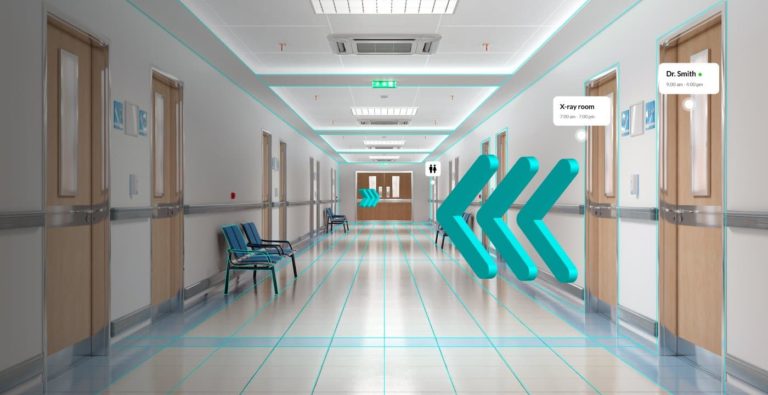
3 Ways Augmented Reality Can Enhance Post-COVID Healthcare
Augmented reality (AR) is undergoing impressive growth. After an initial sales decline in 2020, the latest forecasts are trending upward. Some projections chart an increase from $15 billion in 2020 to $77 billion in 2025. One major reason for this boost is renewed interest from a healthcare industry rapidly seeking contactless solutions in the wake of COVID-19. But what happens when the pandemic ends and COVID-19 is a memory?
Pandemics often drive technological innovation, from the invention of new vaccines to 3D-printed ventilators. These advancements continue to thrive and evolve well beyond their adoption, and AR-based healthcare is on a similar trajectory. As developers, our task is to continue innovating and expanding on this technology’s long-term value.
Here are just a few examples of what we can expect in the years ahead.
Indoor navigation will limit disease transmission
At COVID-19’s peak, more than 130,000 hospital beds were in use in the United States. For many healthcare facilities, this overwhelmed their capacity and increased the likelihood of exposure to the virus. As a result, hospitals are using this time to rethink room occupancy and hospital foot traffic. By helping patients navigate hospitals as efficiently as possible, they limit the number of exposure vectors.
AR-powered indoor navigation was an area of interest among healthcare organizations before the pandemic. Today, it takes on new importance — facility managers want to quickly calculate room occupancy and help patients efficiently orient themselves to their surroundings. We can achieve this with some relatively minor implementations:
- Digital twins — virtual replicas of a facility that update critical metrics in real-time — allow facility managers to monitor room occupancy remotely. Digital twins can also simulate hospital traffic patterns to calculate the most efficient pathway to a given location.
- Hospital apps can provide AR navigation and directions that update in real-time to help patients and visitors get to appointments on time and orient themselves in large facilities.
- AR based digital signage can deliver warnings when occupancy is too high, recommend navigation detours, or deliver other essential healthcare messaging.
Smart hospitals will improve patient care
Indoor navigation is just the start of what AR and digital twins can do for healthcare. The next step is a full-fledged smart hospital — a medical facility where all electronic devices are connected and data is leveraged for smart operations.
Standard smart buildings are increasingly common in the commercial enterprise space, but the benefits can also extend to medical facilities. Smart hospitals make it possible to automate various processes, identify and reduce inefficiencies, conduct remote maintenance tasks, and reduce operational costs. With a digital twin, these facilities can also run digital emergency simulations or track equipment availability through the building.
Building or upgrading a smart hospital is not an outrageous goal. The newly-opened Cortellucci Vaughan Hospital in Ontario, Canada is a perfect example of the technology in action. Cortellucci Vaughan uses seventy-five automated workflows to improve workplace efficiency. The result? Staff have more time to provide patient care. Elevators automatically redirect for rapid response teams. And in an emergency, patient beds and IV machines automatically adjust to positions that benefit doctors and nurses.
Contactless tech will enhance doctor-patient communication.
In the wake of COVID-19, the biggest priority for hospitals is finding ways to implement contactless medical services. As a result, telemedicine appointments surpassed pre-COVID norms by 38x. While data relating to online and app-based appointment booking portals are limited, we can likely expect their use to grow as well.
AR already has a role in contactless hospital navigation, but there are other ways it can assist doctor-patient interactions in the years ahead. For example, AR visualization capabilities can help patients visualize pain symptoms and deliver valuable insights to doctors. Optometrists can work with people experiencing vision loss to recreate their visual experience, or better describe how eyes change during the aging process. We’re even starting to see signs of AR-powered telemonitoring that allows hospitals to monitor non-critical patients from home, freeing intensive care beds for priority patients.
If we genuinely wish to bring about a golden age for AR, we must ensure the technology is robust enough to act as a multifaceted solution for all industries. The most effective way to accomplish this is by uniting multiple applications under a centralized platform for ease of use. Smart hospitals and healthcare facilities have the most pressing needs and the most significant opportunities to advance AR for the benefit of doctors and patients alike.
 Emil Alon is CEO of Resonai.
Emil Alon is CEO of Resonai.

